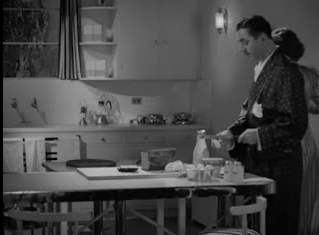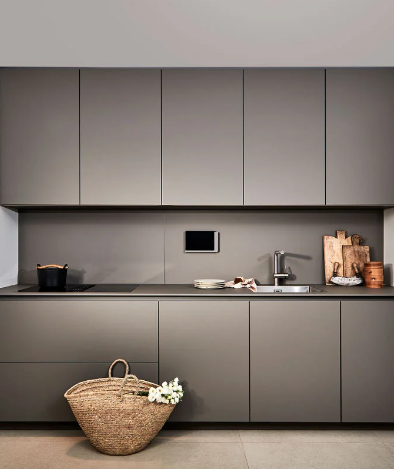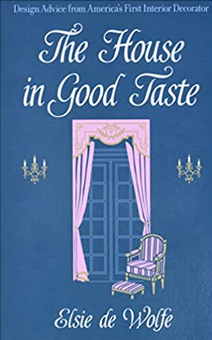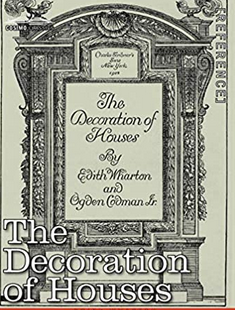The ROMCOM kitchen and the myth of timelessness.
- tipsy modernist
- Nov 29, 2022
- 5 min read
Updated: Sep 11, 2023

The holiday season is here! Which means it's also ROMCOM season.
During these cold dark days you might find yourself watching (or perhaps being forced to watch) “beloved” holiday ROMCOMS such as the aptly titled Holiday or some other Nancy Meyers romantic comedy. And chances are that movie will prominently feature an all-white kitchen like the one above. This got me thinking about a recent conversation with a neighbor about kitchen design. Having renovated her own kitchen, she now considers herself an expert, and one of the nuggets of wisdom she imparted to me was that homeowners should “stay away from trendy kitchen design” in favor of “timeless” design. Timeless. This is a word we throw around a lot in design. I’m pretty sure I’ve used it a lot on this blog, probably too much in fact.
So what is timeless design?
When I talk about timeless design, I'm usually referencing a modern or mid-century modern design that looks like it could have been designed today, but was actually designed in 1950 or maybe even 1920. But a timeless design can be from other eras as well of course. A design that looks just as elegant today as it did when it was originally designed. A design that is still just as functional today. A design that is elegantly distilled to its simplest form yet still maintains its function. These are elements of timeless design to me. The Barcelona chair is a great example of what I would call timeless design. Designed in 1929 by Mies Van der Rohe and Lilly Reich, it still looks incredibly modern even though it was designed nearly one hundred years ago. But the Lutyens garden bench,designed by Sir Edwin Lutyens in 1902 and still highly in demand, is also clearly a timeless design.

So what is a timeless kitchen exactly? Does it even exist?
For people like my neighbor, when they talk about a “classic” or “timeless” kitchen, it's the all-white kitchen with paneled door fronts, white-tiled backsplash, stone-ish countertop and stainless steel appliances that they’re referencing. I call this the Rom Com kitchen, because it was basically invented by director Nancy Meyers in her hit movie " Somethings Gotta Give" in 2003. People love this kitchen. Lots of celebrities have this kitchen. It’s a sign that you’ve financially arrived, just like buying a Mercedes or a Birkin bag. But is it timeless? While it may tap into a deep well of nostalgia, its design is clearly derived from the bauhaus style Frankfurter kitchen and its materials seem to have more in common with the Victorian bathroom than any historic or "timeless" kitchen. So really the Rom Com kitchen is an amalgamation of many different eras.

The kitchen as we know it, didn't exist until 1926.
All kitchens today are based on the Frankfurter kitchen design. Continuous countertops, wall-cabinets, appliances and a built-in sink didn’t exist in most kitchens until 1926, when Austrian architect Margarethe Schutte- Lihotzky designed the kitchen as part of the 15,000 apartment units built to house the flood of refugees after World War I. (Did you miss the post on spy and designer Margarethe Schutte-Lihotzky? check it out here.) Prior to this, the kitchen in most middle-class homes was a room with a coal burning stove that contained a table, a free-standing cupboard or hutch for dishes and maybe a sink. Many homes at the turn of the nineteenth century could not afford indoor plumbing and utilized well-water. Indoor plumbing only became widespread by 1930. It most likely had dark wood paneling and wood plank floors and was illuminated by a gas lamp. It certainly was not the gleaming white “timeless” kitchen seen in celebrity homes.
Nor was this gleaming white kitchen seen in the homes of the wealthy. The kitchen in wealthy homes, (strictly the domain of servants), was a typically a vast brick space in the basement or lower level often with a vaulted brick ceiling.There were typically several different fires for roasting and cooking so it needed to be built of fire -resistant materials., not the white bead board seen in the ROMCOM kitchen. There would have been a free-standing marble topped cabinet for butchering meat, another for making pastry, and an enormous cast-iron stove. One could argue that the contemporary style kitchen modeled on the original Frankfurter kitchen with its sleek cabinets and stainless steel, at almost 100 years old is actually more timeless than the ROMCOM kitchen. Just sayin.
The Frankfurter Kitchen,photo courtesy of the MoMA Photo courtesy of Poggenpohl
Timeless versus Trendy
For many people, timeless equals good and by extension good “taste”, whereas trendy equals bad or bad “taste.” We all have our likes and dislikes; full disclosure I am not a fan of the ROMCOM kitchen. (shocking no one) But just because I am not a fan of this style, doesn't mean that it's any less valid than the modern or contemporary kitchen styles I prefer. I happen to like modern design but I recognize that many people don't.
There is no such thing as good taste or bad taste. *

Taste is subjective, contrary to what the “taste makers” say. How we perceive beauty is informed by many things; culture, socio-economic status, age, are just a few of the influences that affect how we perceive the world. Some people think that Italian taste is the height of good taste. Others think it is the height of bad taste. For many the all-beige interior is “classic”, for others the beige interior is the height of “bourgeois” bad taste. Until very recently white, western culture dictated what was beautiful and what was not. Western European culture was seen as the ideal against which all other cultures were compared. Although we are now just beginning to dismantle this hierarchy of beauty and taste, it is still very much entrenched in our way of thinking and in how beauty is portrayed in popular culture and media.
No-one culture, group or person owns “good” taste.
Donald Trump's New York penthouse (seen in the far left image) is considered by many (including myself) to be absolutely hideous. Yet the same aesthetic in the hands of gay icon Liberace, in the middle photo, is fabulously camp to the same group of people. The camp aesthetic was officially inducted into the style hall of fame in 2019, when it became the theme of the "Met Ball" and celebrities were literally tripping over themselves to vie for who could be the campiest. Camp or hideous? It really depends on how you see the world.

Food for Thought
So whether your taste is ROMCOM or modern minimal, both styles originate from the same bauhaus style Frankfurter kitchen. While lovers of the ROMCOM and modernist styles both lay claim to the timelessness of either style, when it comes to kitchen design, I'm not sure that such a thing exists. The ROMCOM kitchen might be the preferred style of rich, white, suburban ladies, (along with the Birkin bag), but that doesn’t make it any more “timeless” or superior to any other kitchen style. There's nothing wrong with wanting that ROMCOM style kitchen.
Just don't call it timeless.
Thirsty for more? Get the recipe for your perfect ROMCOM cocktail here.
* Except for post-modernism. Post- modernism is an abomination.
Shoppables














































Excellent!